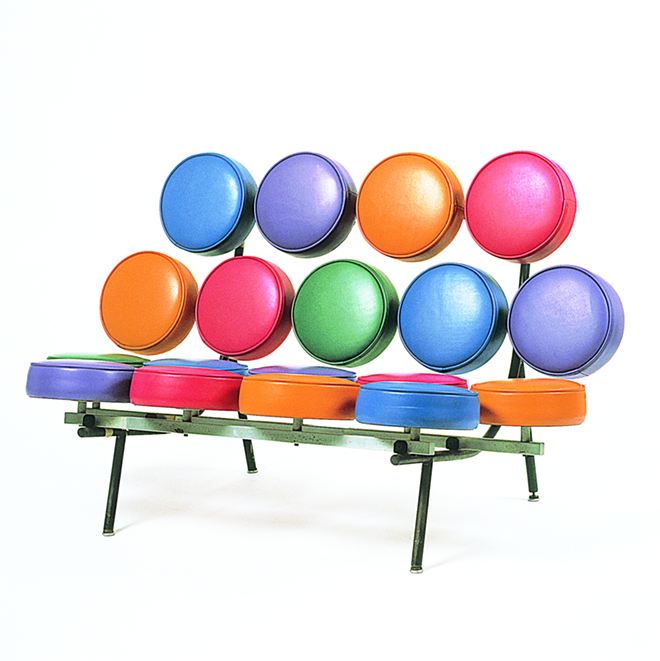
While much modern and contemporary art (still) inspires head-scratching, the tables are turned when a work of art is also a piece of furniture. Take the humble chair. (Or the not-so-humble chair, as the case may be — for now, as ever, a seat isn’t just a place to put your ass, but also a telling status symbol.) While it’s possible to see, in a survey of chairs from the past century or so, the raging passions of modernism and the flaky experiments of postmodernism, it’s also possible to make judgments via a reference point no further than your own rear end.
Would I want to sit on that?
That relatability is a big part of the appeal of A Hundred Years — A Hundred Chairs: Masterworks from the Vitra Design Museum, a traveling exhibition that alights this week at the Tampa Museum of Art. The show isn’t new — since 1996, it has visited venues throughout Europe, the U.S., Israel and Japan — but that doesn’t really dampen its appeal, since the approximately 100 chairs (or chair-like things, including one ottoman and George Nelson’s Marshmallow sofa), dating from 1889 to 1989, that comprise it make up a portrait of 20th-century design that museum-goers are invited to look back on with nostalgic relish.
And that invitation is almost impossible to decline.
What’s wistful and a bit ironic about the exhibit is that several, if not more, of its key chairs — Charles and Ray Eames’ DKR wire dining chair and Frank Gehry’s cardboard Wiggle Chair among them — were intended by their designers as quality furniture within reach of middle-class buyers; time has made them into expensive collectibles and museum objects. The Eameses created their iconic chair (one of many) for a low-cost furniture design competition at the Museum of Modern Art in New York in 1948. Gehry’s 1972 experiment with cheap furniture was so disastrously successful — driving up sale prices for the chair — that he gave up furniture design for architecture. (Today, a Wiggle Chair manufactured by Vitra will set you back around $1,000. And, yes, Vitra is both the organizer of the exhibit and the manufacturer of contemporary reproductions of some of the chairs featured in it, an ethical Möbius strip that I can only shrug my shoulders at for the purposes of this preview.)
These days, the chairs stand as signposts of the utopian imaginings of other eras. Around the same time painter Piet Mondrian was eliminating references to real-world objects in his paintings in favor of a geometric abstraction, the late 1910s and ’20s designer and architect Gerrit Rietveld applied the same style of vertical and horizontal black, red, blue and yellow planes and straight lines to his “Roodblauwe stoel” (Red Blue Chair, 1918).
With more gusto for technology than color, Bauhaus member Marcel Breuer advanced the German school’s commitment to modern design with works like his Wassily Chair (1925), which pioneered the use of steel tubing, inspired by bicycle construction, in furniture. (The chair’s manufacturer named it after Breuer’s Bauhaus colleague, painter Wassily Kandinsky, not Breuer.) Another Bauhaus member, Ludwig “Less is more” Mies van der Rohe, created the iconic Barcelona Chair — a folding, chrome-plated steel chair with leather cushions — for the 1929 World’s Fair in the Spanish city, updating a basic style of chair construction used in ancient Egypt, Greece and Rome with 20th-century materials.
In response to metal scarcity during World War II, American couple Charles and Ray Eames perfected the process of molding complex three-dimensional shapes from plywood — but it didn’t come easily. In 1940, Charles Eames had tried in collaboration with designer Eero Saarinen to produce an organically shaped chair made of plywood for a MoMA competition. Unable to withstand stresses, the gently curved Organic Armchair by Eames and Saarinen (not included in the exhibition) required upholstery to conceal its cracks. A year later, Eames and his wife, Ray, improved the process, which they further honed by producing leg splints for the Navy in 1942, and used it to produce a series of simple, elegant plywood chairs including the LCW (Lounge Wood Chair, 1945) after the war.
The Eameses also led the way in making chairs out of fiberglass and plastic. (See the RAR rocker, 1949-50, or La Chaise, a curvaceous cradle of white fiberglass that could double as a fried egg in a Salvador Dalí painting.) No less elegant than their laminated wood creations, those designs have been just as influential, paving the way for creations like Verner Panton’s Panton-Chair (1959-60). Made in polyurethane foam after prototype versions in plywood and plastic, the S-curving chair — shown in flaming red for the exhibition — resembles a giant tongue flicking up through space to balance a sitter gently in its folds.
In the postmodern climate of the 1970s and ’80s, the seriousness of innovation in prior decades falls away to reveal some of the silliest chairs you’ll ever see — Alessandro Mendini’s Poltrona di Proust (1978), a voluminous baroque throne covered with dots of color like a Georges Seurat painting, and Robert Venturi’s Queen Anne (1979-1984), a flat plywood homage to an historic chair silhouette printed with a floral tablecloth pattern and stripes from a Jasper Johns painting. As mash-ups of disparate visual sources, they’re fun object lessons in the postmodernism of a certain moment, but they’re also damn ugly chairs.
What I will take from the ’80s is Ron Arad’s Well-Tempered Chair (1986), a construct of bent sheet metal that looks like a cross between a gift bow made of steel ribbons and an inflatable chair.
Yeah… I'd sit on that.
For information on the chairs in the exhibition, I referred to the exhibit catalogue 100 Masterpieces from the Vitra Design Museum Collection and the 2011 documentary film Eames: The Architect and the Painter.


















